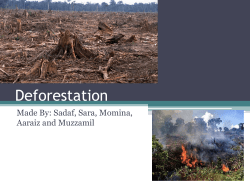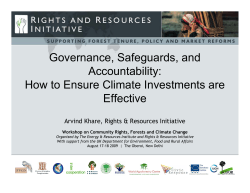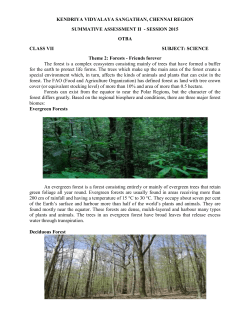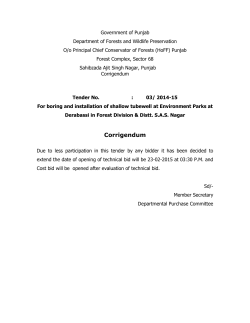
GA Committee 2 Preventing Deforestation
YMCA Youth & Government Model United Nations Distr.: General General Assembly March 2015 Original: English TOPIC PREPARATION GUIDE Economic and Financial Committee: Preventing Deforestation A/15/TPG/2 Section 1 Topic Background 1.1 Deforestation, or the removal of Earth’s forested land on a major scale, continues to be a major issue for our planet. According to the Earth Policy Institute, forests cover 31% of the earth’s surface. This represents 4 billion hectares, down from 5.9 billion hectares at the start of the 20th Century. 1.2 since the 1990s Global deforestation has resulted in an average loss of 16 million hectares of forest annually (roughly the size of Michigan). D4 station rates do not fully capture the damage done to the world forests. Selective logging, road construction, climate change, and suburban expansion further degrade the health of the world’s forests. 1.3 The primary causes of deforestation can be lumped in two categories: natural causes and human activity. Wildfires and overgrazing account for most of the natural loss of forested land. Human causes of deforestation include logging, mining, urbanization, and mass agricultural expansion. Forests may help provide a source of income for people who are able to sell timber for profit, but these trees are often not replanted. Forests can also be used for their valuable minerals; for example, the Amazon Rainforest contains copper, iron ore, and gold. Finally, the clearing of land for agricultural, commercial, and residential purposes is the most common causes of deforestation 1.4 the global impact of D4 station is immense. When forested land is cleared many species of animals lose their homes. In addition, trees serve to clean carbon dioxide from the air reducing global greenhouse effect. When those trees are cut down that carbon dioxide is released into the atmosphere. According to the World Resources Instutute up to 17% of annual greenhouse emmissions can be attributed to global loss of forests. Section 2 Previous International Actions • • In 1972 a Conference on Environment and Development (UNCED) was held in Rio de Janeiro to discuss the issue of deforrestation. From this conference came a report commonly referred to as the “Forrest Principles.” This document asserted that while nations had the right use their natural resources, they also have the responsibility to provide protection regulation and conservation. In 2000 the United Nations Forum on Forests (UNFF) was created by the United Nations Economic and Social Council. The UNFF’s Mission was the “management, conservation A/15/TPG/2 • and sustainable development of all types of forests and to strengthen long term come political commitment to this end” The UNFF has four areas of focus: o To protect, conserve, and restore the worldforest through sustainable forest management o To assist people who are dependent on forests for a living o To relocate the production of forest-derived products to sustainably managed forest. o To ensure that any conservation efforts are backed with sufficient financial support. Section 3 Guiding Questions • • • • • What percentage of your nation’s land is forested? Does your nation rely on timber as a revenue source? What are your nation’s policies regarding sustainable forests? How do we balance the need for affordable housing with a growing world population? How do we protect the economies of timber producing countries while promoting the use of renewable resources? Section 4 Further Research • • 2 Fiset, Nathalie. "Harmful Effects of Deforestation." Article Base: Free ONline Articles Directory. 13 Apr. 2007. 28 Apr. 2009http://www.articlesbase.com/environmentarticles/harmful-effects-of-deforestation-131219.html. "Five Tips For Preventing Deforestation." EDU.UDYM.com Education Articles. 14 Aug. 2008. 28 Apr. 2009 http://edu.udym.com/five-tips-for-preventing-deforestation/.
© Copyright 2025





















